
3 tips to Efficiently Build Back Muscles for your Horse
“Wow! Your horse’s back is rock-solid”… You’ve probably heard this a hundred times before but its inference “Wow, your horse’s abs are rock-solid” is less popular. That’s a shame! Most riders tend to focus only on their horse’s back muscles while neglecting the abdominals too often. But one doesn’t come without the other!! I’ll try to explain to you why it’s useless to try to build up back muscles if you forget the abs.
I want to give special thanks to Dr Isabelle Burgaud whom helped me write this article.
Table des matières
- Firstly, what does great back look like for a horse?
- Important point #1 – The back’s “position” depends on the neck’s “position”
- Important point #2 – To build up muscles, the back has to be relaxed
- Important point #3 – To build muscles in your horse’s back you need to build muscles in its abdominals first
- A few exercises to work on the abdominals
Firstly, what does great back look like for a horse?
A great back is one that isn’t in the shape of a basin, therefore it’s not shallow and rather straight. To go into more depth, it means the thoracic concave side is reduced. In addition to that, it’s a muscular back so the muscles are tonic but not rigid.
The million dollar question is then: “How can I get this result?”

Important point #1 – The back’s “position” depends on the neck’s “position”
All this thanks to the “supraspinous ligament”. Be sure to remember the name.
The horse’s back actually possesses an extremely well conceived ligament system. It contains the nuchal ligament and the supraspinous (or supraspinatus) ligament.
The supraspinous ligament links the top (the processes) of the vertebrae to the sacrum. It continues in a nuchal ligament which will link the cervicals to the withers (so the first thoracic vertebrae). It is in the shape of a fan.
The nuchal ligament has two parts:
- the funicular part, which links the withers to the top of the skull (it’s right under the mane)
- the lamellar part, which links the withers to every cervical vertebrae
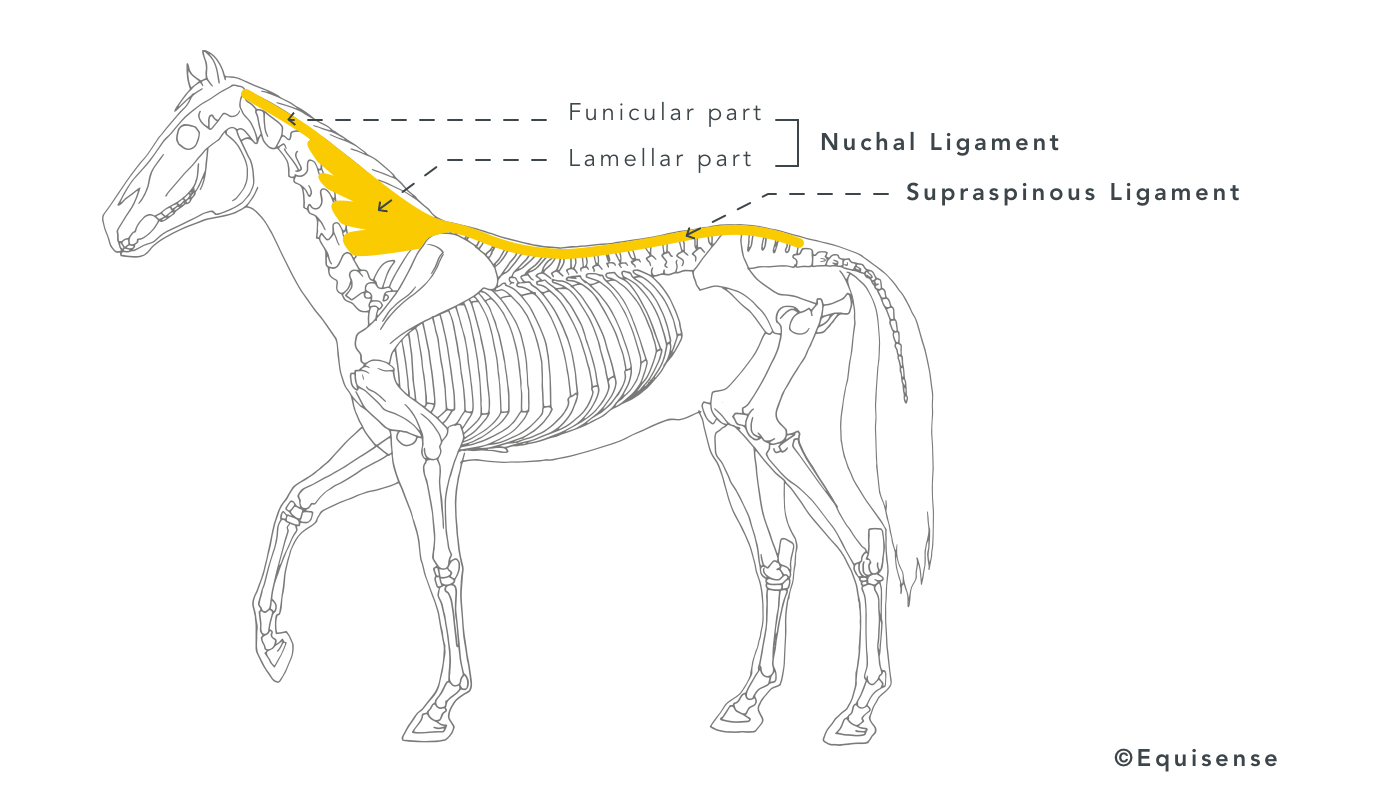
As a consequence of these ligaments existing when the horse lower its head, the horse’s back is pulled up automatically.
You can try to “measure” this yourself. Balance a wooden stick over your horse’s withers and its rump. Keep its head up and measure the space between the lowest point of the back and the stick. Repeat the same process with the horse’s head down. You’ll see the space is way smaller. The horse’s back was pulled up.
So when the horse’s head is down, its back forms a bridge. It’s this bridge that allows it to carry a rider while leaving the back muscles to work freely.
Important point #2 – To build up muscles, the back has to be relaxed
What you need to keep in mind is that the back muscles aren’t designed to carry a rider. The ligament system is taking care of that. The back muscles operate the horse’s stride and its bend (amongst other things, to keep it short). But they have to be relaxed and flexible in order to work correctly.
“The back muscles aren’t designed to carry a rider”
If these muscles are rigid because they need to carry the rider’s weight or to absorb their movements or even because the saddle hurts hurts the horse, the horse’s movement won’t be pretty. That’s what happens when you see horses with their heads high, their backs hollow and no engagement in their hind.
Let’s talk about muscle chains
From a muscle perspective, it’s important to talk about both muscle chains: the dorsal chain and the ventral chain.
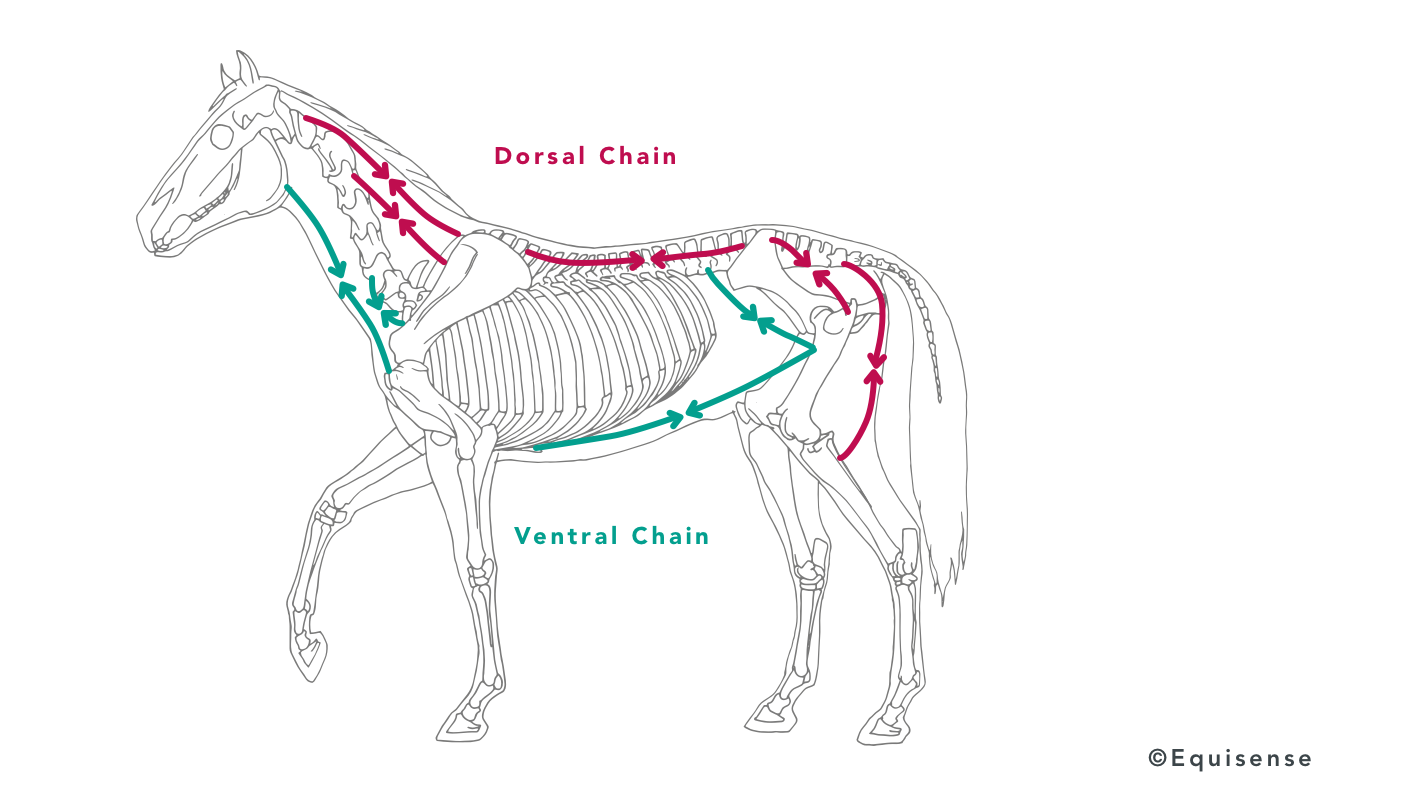
The dorsal chain muscles (or “top line”) are basically the muscles laying on top of the vertebrae. They are the dorsal cervical muscles (deep muscles that make up the top part of the neck), the “erector spinae” muscle group (located around the back), and the gluteal and femoral caudal muscles which allow the horse to move its hind legs back.
All of these muscles are torso and hip extensors. Their contraction allows the neck to pull up and to move the hind legs back and in doing so to “sink the back”. You must be starting to understand: this chain is predominant for badly ridden horses.
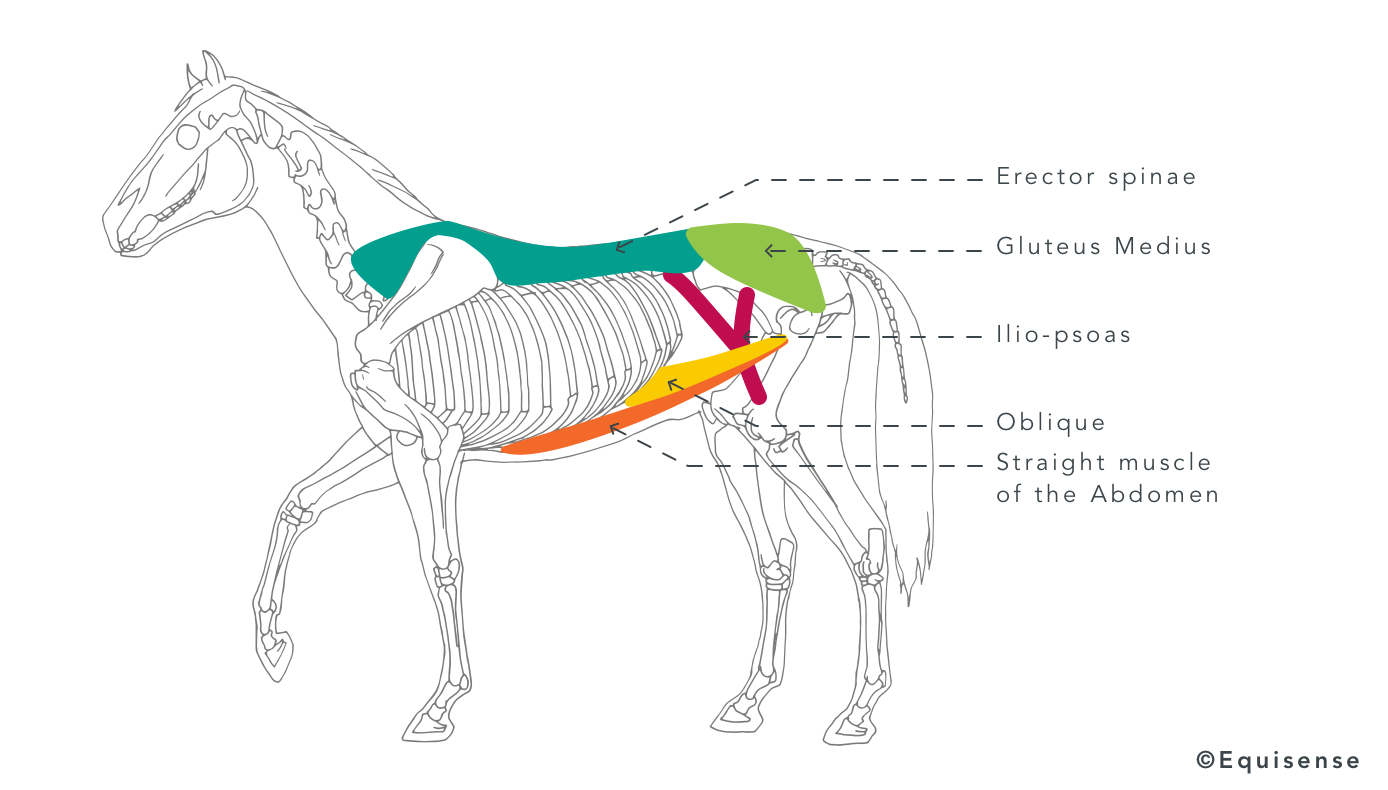
The ventral chain however is made up of the ventral cervical muscles (the muscles at the bottom of the neck allowing it to bend), the abdominal muscles and the femoral cranial muscles. Those allow the horse to bring its hind legs back under itself.
All these muscles are therefore neck, torso and hip flexors. They allow the neck to lower itself because, yes, what we call a “neck extension” is actually a low cervical flexion. Their contraction allows the horse to lower its neck, to bring back its hind legs under itself and in doing to so pull up the horse’s back. This chain is predominant for well ridden horses!
Now that we know all this, everything is simpler.
Important point #3 – To build muscles in your horse’s back you need to build muscles in its abdominals first
You understand it now, when the abdominals contract there’s a hip flexion. The hind legs are therefore brought back under the horse.
The hip flexion will then induce a tension in the dorsal ligament system. This way the bridge will rise to carry the rider. This bridge will allow the dorsal chain muscles to work freely and in doing so to get stronger while relaxed.
On the other hand, when the abdominals aren’t working, the pelvis and the hind legs won’t be in flexion and the ligament bridge won’t be happening. The back muscles will instead be working and they will rigidify and the horse’s movement will be degraded.
No abs, no back!!!
So what lessons might be drawn from this? You have to keep in mind that top line reinforcement will only come after toning the ventral line. Also, remember that the dorsal chain has to be relaxed in order to get the ventral chain properly functioning. Both have to work together.
They are antagonistic groups, like the quadriceps and the hamstrings muscles in the thigh. Try to bend the knee when your quadriceps is rigid (spoiler: it won’t work). In this case it’s similar: the abdominals can’t work properly if the dorsal chain isn’t relaxed and vice versa.
Both chains move at the same time to bring balance to the movement. When both of them are toned and work in a balanced way we reach the collected strides! The erector spinae muscles pull the neck base up, the abs engaging and flexing the hind legs, the back toned and pulled up… But you’ll only obtain this after long hours of work.
By the way, what can you work on to grow your horse’s abdominal muscles?
Learn more: How to build muscles in your horse’s shoulders
A few exercises to work on the abdominals
Let me give you 3 exercises useful for abdominal reinforcement since, you get it, there’s no growing back muscles without growing abdominal muscles.
Exercise #1 – Neck extension
It’s a pretty simple exercise but it’s really good to build up abdominal muscles.
Professor Jean-Marie Denoix explains it well:
“When the supraspinous ligament is put under tension, it limits the thoracolumbar flexion and increases the amount of work the abdominal muscles have to put in to keep the engagement.” (Denoix, 2014).
Let’s translate that. Basically by lowering its head, the horse’s supraspinous ligament tenses and the back is pulled up. So far so good. But the thing is, it’s going to “pull the hind legs behind” (cf. important point #2). This way if you want to get hind legs engagement, the abs will work harder.
This exercise is even harder if you do it uphill!
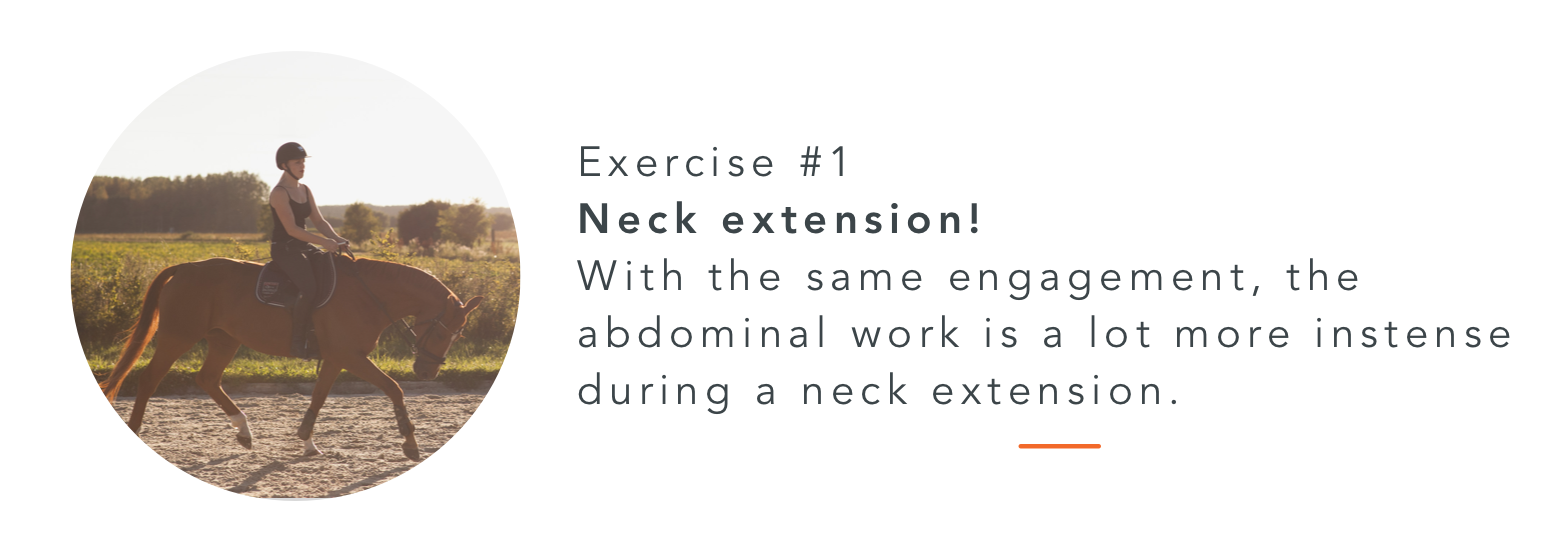
Exercise #2 – A few steps back…
Working on going backwards offers a lot of advantages, notably the fact that it’s slow work and it makes the horse work on its coordination.
For abdominals the point of going backwards is to work on muscles in a fixed point inversion, in this case the iliopsoas muscle. This muscle links the lower parts of the lumbar vertebrae and the ilium with the top of the femur. It’s part of the abdominal muscle (lumbar region). “It’s the key muscle for hind legs engagement” (Denoix, 2014).
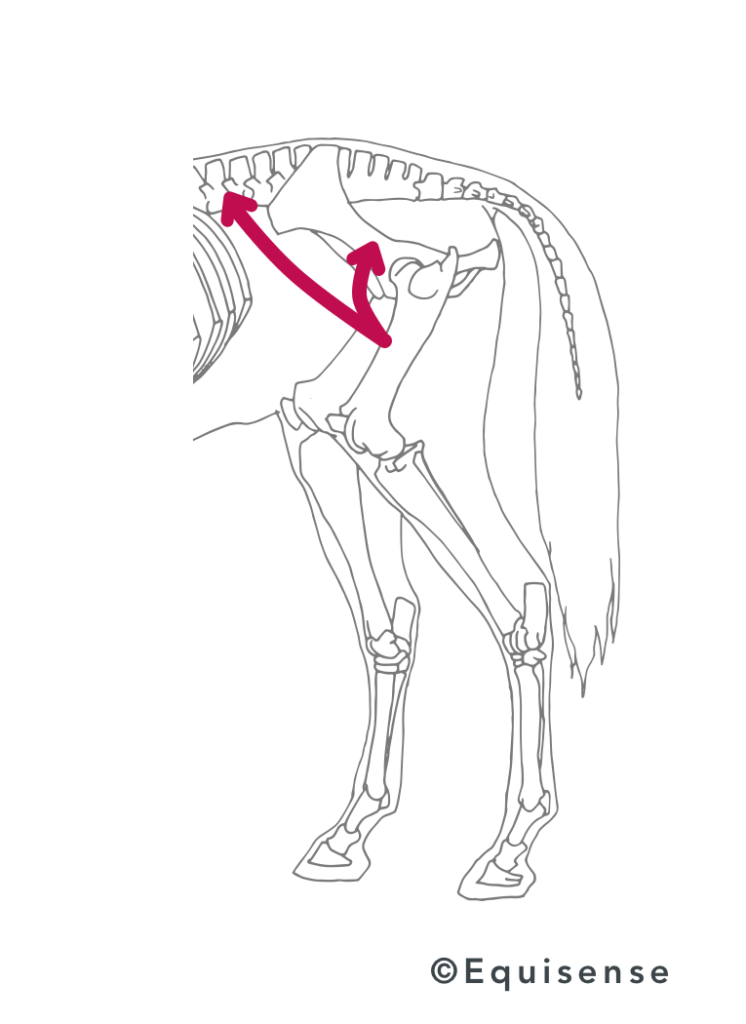
When the horse moves forward, the fixed points of the iliopsoas are the vertebrae and the ilium. It’s going to pull the hind leg forward. When the horse goes backwards, the opposite happens! The fixed point becomes the femur, and the muscle will pull the body backwards which is harder.To give you a clearer image, imagine yourself laying down on your stomach at the end of your bed, arms hanging and act out the push up movement with your arms. That’s too easy! In this case, the fixed point is your body and the mobile point is your arms. Now, actually do push ups. It’s a bit harder… because you reversed the fixed point (now your hands) and the mobile point (your body). Going backwards is pretty much the same thing.
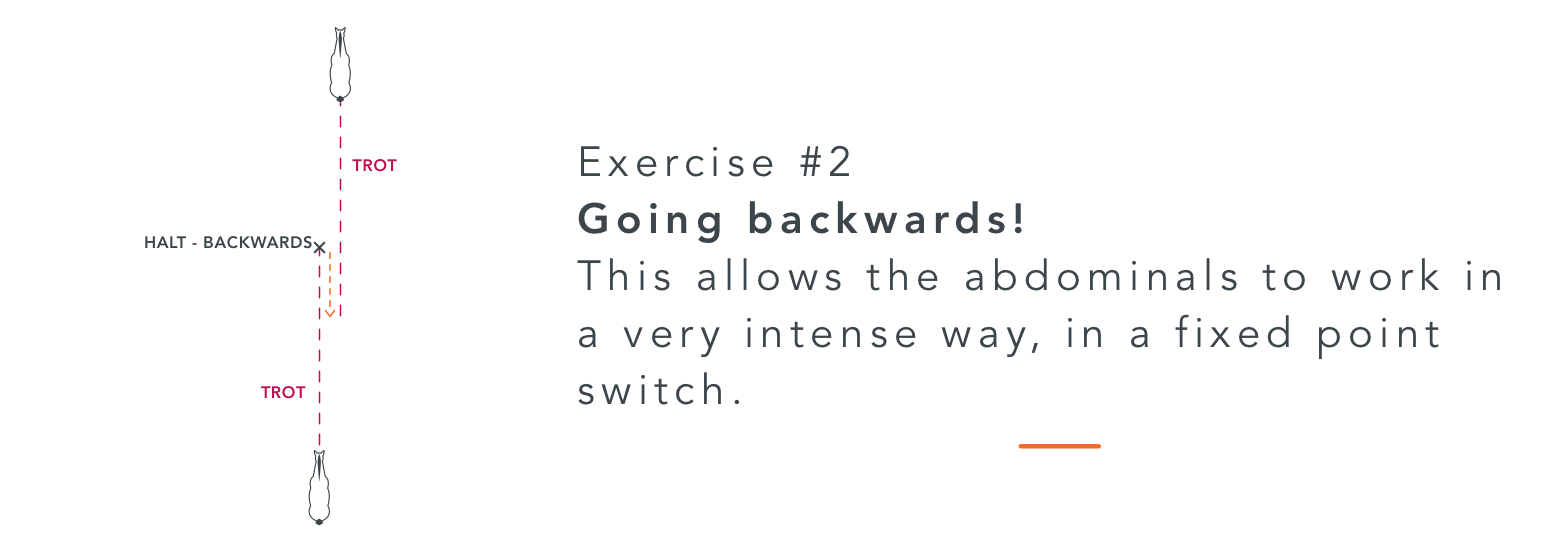
🔎 On the same topic: Here is how to strengthen your horse’s hindquarters
Exercise #3 – Bounce jumps
Bounce jumps are really good to make the abdominal muscles work with quick succession of flexions and extensions.
As a matter of fact, when landing from the first fence, the front legs will land then take off immediately to go over the second fence. The hind legs will then land to directly take off as well. There is therefore a phase in which the forelegs are already going to jump and the hind legs haven’t landed from the first jump yet. The length of this phase depends on how fast you enter the exercise, and the back flexion and the abdominal contraction is huge during this phase.
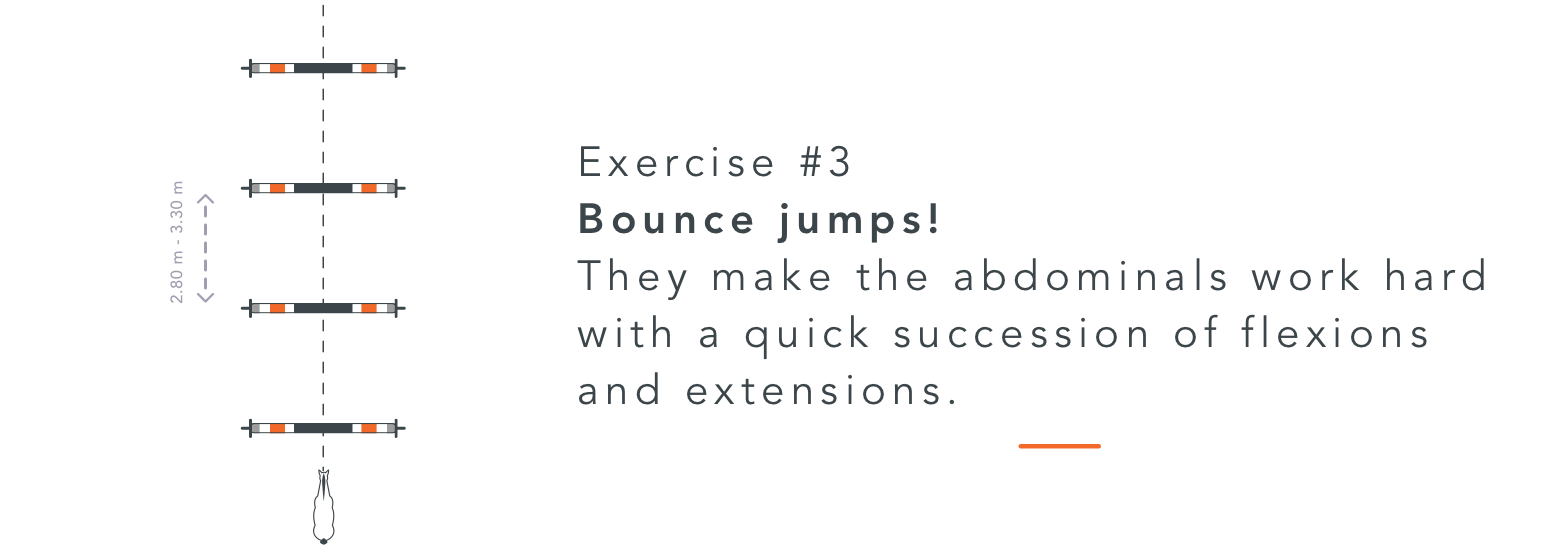
If you combine bounce jumps uphill then your horse is sure to get a “six pack”. I’m feeling that after this article is published, Equisense Motion S will count an incredible increase in bounce jumps 😉
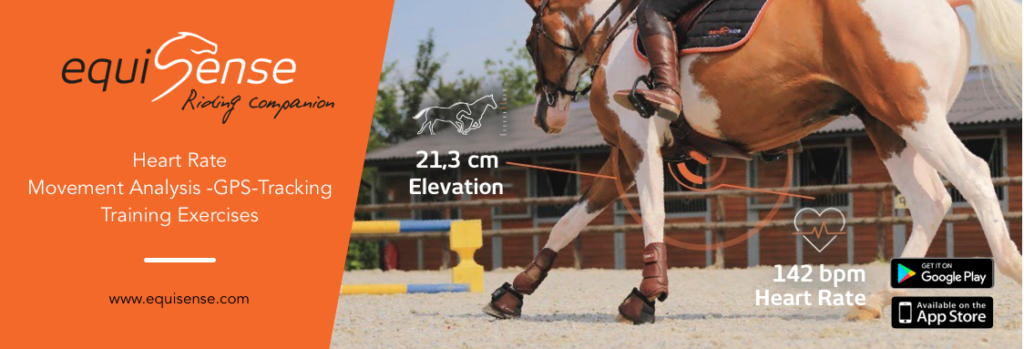
Now when you’ll see a horse with a big belly, you won’t say “he’s cuddly”, you’ll say “he needs to build up his abdominal muscles, let’s work on uphill bounce jumps to reinforce its back!”
See you soon for another article,
Camille Saute,
R&D leader at Equisense.
Bibliographie
Denoix J.M. (1997), Approche de la kinésithérapie du cheval. Paris, France: Maloine.
Denoix, J.-M. (2014). Biomécanique et gymnastique du cheval. Paris, France: Vigot.
Prach, A. (2011). Etude de la musculature du rachis du cheval par mesures echographiques. Vetagro Sup Campus vétérinaire de Lyon.
Your training articles are well researched, written and presented and I am sure very useful to many riders. I am looking forward to receiving my Motion S in the near future and seeing how it works in practice…..